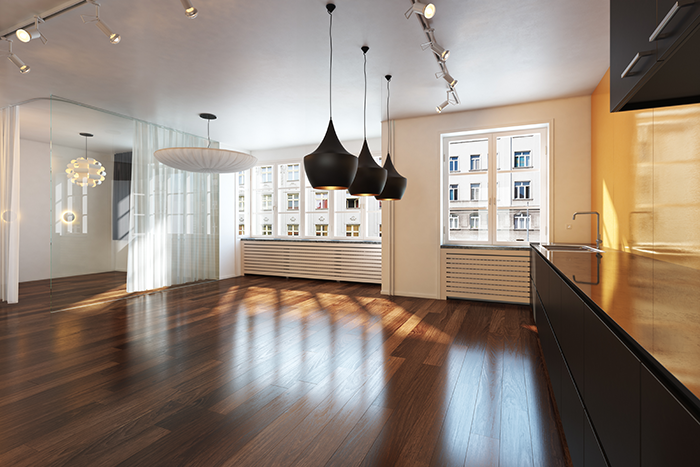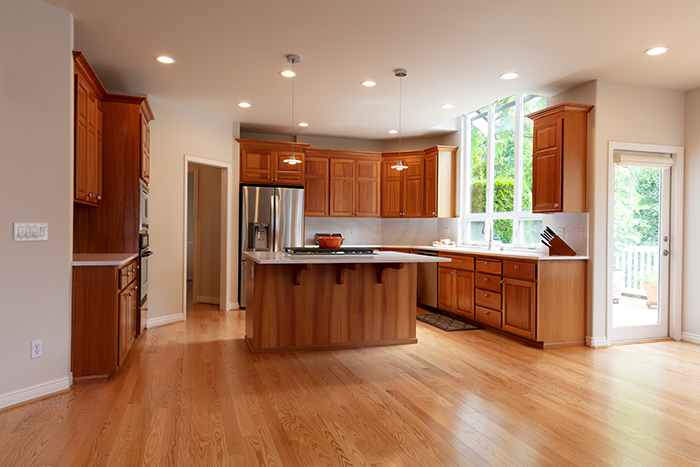How to refinish hardwood floors
Brand new hardwood floors are a stunning feature in almost any home. However, it is natural for them to dull or wear over time. Scratches, scuffs and holes in the wood can make your home begin to show its age.
Replacing hardwood floors can be an expensive and time-consuming endeavour, because the original floor must be removed before installing a new one. However, the refinishing of existing hardwood floors can be a rewarding D.I.Y. project and could significantly raise the value of your home.

How to refinish a hardwood floor
There are several steps in hardwood refinishing:
1. Assess
Before attempting any refinishing project, take the time to assess your floors. Make note of any areas where there are large or small holes, cracks, or discolouration.
Make sure your floors are thick enough to refinish: the easiest way to do this is to remove a loose plank and look at its cross-section. If the wood is solid with a continuous grain, it is solid hardwood. If different layers of wood are visible, then it is an engineered wood floor.
If removing a plank from your existing floor is not feasible, you can look under vent covers and registers or remove the metal saddle at an exterior doorway to expose the wood.
Can engineered hardwood floors be refinished?
Unfortunately, you cannot sand and refinish engineered hardwood floors. The wood needs to be at least ¼ inch thick, otherwise you risk sanding through.
2. Prep
Move furniture, window treatments and pull up any rugs or carpeting in the room. Find and hammer down any protruding nails. Check for squeaks in the wood and secure loose floorboards with finishing nails. Seal air vent covers with plastic or tape to prevent dust caused by sanding from getting into your ductwork. Use plastic sheeting to seal doorways and keep dust away from the rest of the house. Remove baseboards or quarter round with a small pry bar and a piece of wood to protect the baseboard. Label each baseboard as you remove them so they are easy to reinstall when the floor is finished. Fill any holes or cracks in the wood with wood filler using gloves and a putty knife.
3. Sand
Use a drum sander rented from a home
improvement store. Since these machines can sometimes be difficult to control,
practise on a large sheet of plywood until you are comfortable. Make sure to
wear a respiratory mask and eye protection. Start on the floor with a very
coarse sandpaper and work in 3 - 4 foot sections, overlapping by 3 - 4 inches
(or one board). Move at a slow, steady pace with the grain of the wood, taking
care not to stop abruptly as this can create permanent marks in the floor. Each
piece of sandpaper should cover approximately 20 feet. Check the sandpaper
regularly and replace as soon as it looks worn.
For the edges of the room, use the same grit sandpaper and an edge sander to get right up to the wall. Repeat the process using finer and finer sandpaper on both the drum sander and the edge sander. Each round of sanding will achieve a smoother surface leaving repaired holes or cracks flush with the floor surface. Vacuum and wipe dust from the floor between each step.
Once you have finished sanding, you can buff the floor using fine grit sandpaper on a pole sander or rent an industrial buffer rented from a home improvement store.
4. Stain
If you want to change or enrich the colour of the wood, you can apply a stain with a brush, lambswool applicator or staining sponge. Make sure the room is well ventilated and you wear eye protection and a respiratory mask. Work from the far corner of the room towards the door. Apply stain in the direction of the grain in 3 - 4 foot sections at a time. Wipe excess away before moving to the next area.
5. Seal
After the stain has dried or the natural floor is clean, you can seal the wood with an oil or water-based sealant. Experts recommended applying a fresh coat of sealant every two years to maintain the integrity of wood floors.

Cost to refinish hardwood floors
In general, the cost to refinish hardwood
floors is less expensive than the cost of replacing them, because you do not
have to pay for the old floor to be removed before the new floor can be
installed.
Factors that dictate the final cost of any
project are size, extent of damage, cleanup, and whether or not you will pay
for the removal of previous flooring or furniture,
You can use a hardwood floor refinishing cost calculator to get an idea of what you can expect to pay.
Hardwood floor refinishing can be a rewarding way to improve the decor and increase the value of your home. If you have any problems or need guidance about specific floors such as parquet, enlist the help of a certified professional contractor.
Are you passionate about real estate? Subscribe to the Centris.ca newsletter now.
See also:
How Much Does a Heated Floor Cost?
Everything you need to know about electric floor heating
Bathroom decoration: Revamp ideas at low cost